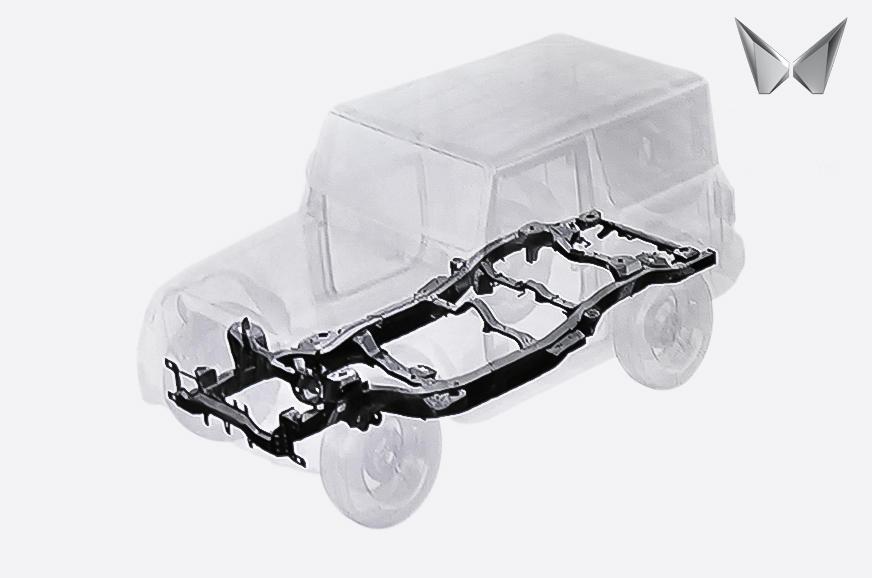
Mahindra will reveal its much awaited new-generation Scorpio (codename: Z101) with a new moniker, Scorpio-N, on June 27, while the current Scorpio will continue to be sold alongside and henceforth called the Scorpio Classic.
With the launch of the new Scorpio-N, Mahindra will have a total of seven ladder frame vehicles in its portfolio. Currently the list includes the Thar, Bolero, Bolero Neo, Marazzo, Alturas G4 and the Scorpio Classic. The ladder frame line-up will further expand when the carmaker launches the five-door iteration of the Thar in 2023.
While the company does have monocoque-based models in its portfolio – like the XUV300 and the XUV700 – the number of ladder frame models in its line-up is higher; in fact, it's more than any other car brand in India. In today’s times when monocoque constructions are preferred, why is Mahindra still betting big on ladder frame models?
The ladder frame legacy
Mahindra entered the automotive business in 1945 when it began assembling Willy’s Jeep under license in India. A tough, four-wheel drive, body-on-frame vehicle was intended to take on the challenging Indian roads with ease. Soon Mahindra was established as the Jeep manufacturer in India, and it later went on to produce light commercial vehicles and tractors.
In the years that followed, Mahindra moved on from being just the assembler of SUVs to makers of one. In 1984, it released the Armada – a body-on-frame SUV based on the CJ-5 Jeep. The model continued to be on sale till 2001. Mahindra launched two more ladder frame models – Bolero in 2000 and the first-gen Scorpio in 2002. The first-gen Scorpio was also Mahindra’s first model for the global market. After the launch of the Scorpio, Mahindra continued bringing in ladder-frame models like the Xylo, Quanto and the TUV300.
This strategy has worked as most Mahindra models are positioned either as utilitarian vehicles meant to tackle rough roads and carry heavy weights, or as off-road machines. It seems Mahindra does not want to give up on their ladder frame legacy so easily, and, therefore, is continuing to build them.
Different strokes…
The Indian automotive market is distinctly divided into urban and rural and in both sets there exists sufficient demand. Urban buyers prefer more sophisticated, easy to drive models, whereas the rural buyers want something that's more rugged and tough to take on the tough terrain. Having both ladder frame and monocoque models enables Mahindra to cater to both kind of buyers.
For instance, where most brands have just one sub-four-metre, compact SUV in their line-up, Mahindra offers two – the XUV300 and the Bolero Neo. The monocoque-based XUV300 is better suited for well-paved roads, while the ladder-frame Bolero Neo is better equipped to handle the rough terrain.
Also the Thar, which is aimed at off-road enthusiasts and lifestyle buyers, is based on a ladder-frame construction, while the XUV700, which is positioned as a tech-savvy, family SUV, is based on a monocoque construction.
A differentiator
As more manufacturers move towards monocoque constructions, having ladder frame models helps Mahindra stand out in a crowded market. However, this strategy hasn't worked for the brand each time.
For instance, the ladder frame-based Marazzo MPV hasn’t really caught on. In FY22, it sold only 1,692 units, only a fraction of the segment leader Maruti Suzuki Ertiga, which recorded 1,17,150 unit sales. In this price bracket, buyers seemingly prefer the more sophisticated monocoque construction for MPVs, and the strategy to go with ladder-frame construction with the Marazzo hasn’t seemed to have gone well for the carmaker. It didn’t help also that the Marazzo had a few rough edges that stick out against the more refined Ertiga.
The commercial angle
In addition to passenger vehicles, Mahindra also has a comprehensive line-up of commercial vehicles, including three-wheelers, small trucks, pick-ups and large trucks. Thus, ladder frame models are certainly a part of their repertoire.
With a ladder frame, Mahindra can engineer applications for commercial vehicles too, case in point being the Bolero pick-up truck and the Bolero SUV. Moreover, with investments already made in ladder frame and only incremental updates required along the way, building such vehicles is a very profitable venture for the company.
What is ladder frame and monocoque construction?
Ladder frame constructions date back to the very first cars. There are two components – a rigid ladder-like frame that houses the entire running gear and a separate body shell is mounted on top. The biggest advantage is that the frame can endure a good deal of use and load, while the body shell does not have to withstand the loads. Thus, this is preferred for heavier applications.
A monocoque construction, on the other hand, has only a rigid body shell with all the running gear mounted directly to it. With the absence of the ladder frame, vehicles built like this are light in weight and thus this construction is preferred for most passenger applications.
Also see:
New Mahindra Scorpio-N vs Scorpio Classic: design changes
Sting operation: The Mahindra Scorpio origin story
https://ift.tt/m5zEGbP



